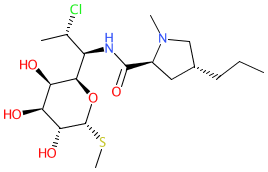GtoPdb is requesting financial support from commercial users. Please see our sustainability page for more information.
|
clindamycin is an approved drug (FDA (1970))
Compound class:
Synthetic organic
Comment: Clindamycin is a semisynthetic lincosamide antibacterial with broad-spectrum activity [1]. The compound also has antimalarial activity.
Clindamycin is one of the key access group antibacterials on the World Health Organization's Model List of Essential Medicines (link provided in the Classification table, under the Summary tab below). The Malaria tab on this ligand page provides additional curator comments of relevance to the Guide to MALARIA PHARMACOLOGY. |
|
|||||||||||||||||||||||||||||||||||
| No information available. |
Summary of Clinical Use  |
| Clindamycin is used to treat a wide range of bacterial infections. These include bone and joint infections, gynaecological infections, intra-abdominal infections, lower respiratory infections, septicemia and skin infections. A combined therapy of clindamycin with fosmidomycin to treat uncomplicated P. falciparum malaria shows promising results, progressing to Phase 3 (NCT00214643). It is also used to treat uncomplicated malaria (particularly useful in areas where chloroquine or multidrug-resistant strains of P. falciparum are found) and as an effective treatment for severe malaria, when used as a combination therapy [6]. It should not be used as a monotherapy for malaria treatment due to a delayed antimalarial effect (see MOA for more details). |
Mechanism Of Action and Pharmacodynamic Effects  |
| Antibacterial MMOA is reversible binding to the 50S ribosomal subunits to prevent peptide-bond formation by sterically blocking A-site tRNA positioning at the peptidyl transferase centre (PTC) and thereby inhibiting bacterial protein synthesis [3]. In Plasmodium, pharmacological concentrations of the compound kill the parasite in the lifecycle after treatment starts. It is thought that clindamycin inhibits the production of proteins encoded by the apicoplast genome, leading to a subsequent loss of apicoplast function and a possible explanation for the delayed antimalarial effect [2]. |
| Clinical Trials | |||||
| Clinical Trial ID | Title | Type | Source | Comment | References |
| NCT00214643 | Efficacy of Fosmidomycin-Clindamycin for Treating Malaria in Gabonese Children | Phase 3 Interventional | Albert Schweitzer Hospital | ||
External links  |
|
For extended ADME data see the following: Drugs.com |









